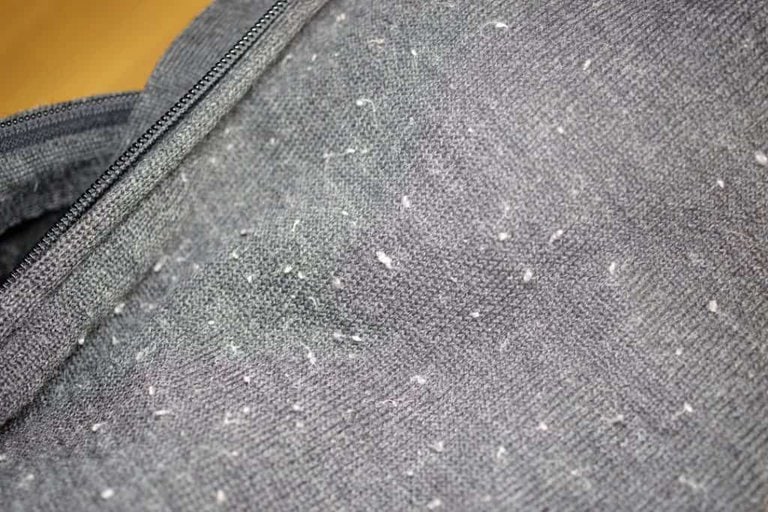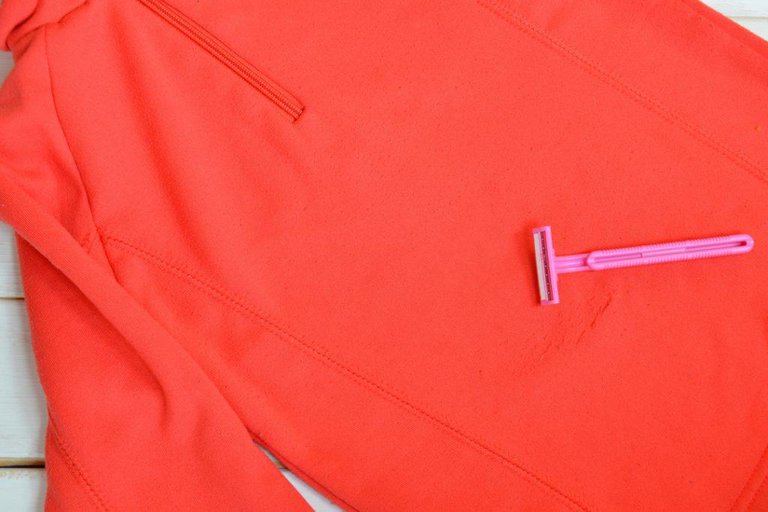The best way to remove lint balls on sheets is with an electric fabric shaver, which will remove them easily and quickly. If you don’t have a specialized tool to hand, then a shaving blade can be a great alternative.
Lint balls can be annoying and look terrible on any piece of fabric. Imagine you are getting ready to go outside for a nice walk and your favorite hoodie is full of lint balls, or you are going to a dinner party and your sweater looks terrible because of lint.
Also, it is quite frustrating when you go to sleep and your bedsheets are full of those irritable bits of fabric. It is helpful to know some facts regarding lint balls before we jump into the question of how to remove them.

What Are Lint Balls?
Lint balls, also known as pills or bobbles, are loosened cloth fibers and are quite common among cheaper clothes or sheets. With time these fibers start to get together and they create small balls. In the textile industry, this process is known as pilling and it has four stages.
There are quite a few reasons why this happens. For those who love the feeling of smooth cloth or sheet, lint balls are a nightmare, both physically and visually.
Thankfully there are a few ways you can remove them to get your clothes looking like new again.
How Are Lint Balls Formed?
There are several reasons why lint balls are formed, but the main one is the textile characteristics (i.e. type of fibers used and their manufacturing).
Other factors increasing the probability of pilling are the environment, process of washing, and how long you’ve had the item of clothing
Materials such as linen and silk are known to pill less than others, whereas the opposite can be said for cotton, and wool. Also nylon, polyester, and acrylic are materials that tend to pill, and it is harder to remove lint balls.
The higher the number of fibers used in the material, the higher the chance of pilling as there are many ends of fibers. Additionally, low-quality materials tend to have weaker fibers, or some companies mix materials when they make their products.
With mixed fibers, lint balls can be harder to remove. This is because the weaker piling fibers are held into the cloth or sheet by the stronger ones.
If not treated properly, you can end up ruining the fibers even more.

Do Lint Balls Pose Any Health Risk?
Lint balls can carry bacteria and viruses, as can any fabric but the balls make them more prominent which can be an issue if you have a cut or are recovering from surgery.
For workers in the textile industry, lint can be very dangerous. A lung disease called byssinosis is caused as a result of excessive inhalation of cotton dust or lint.
When you remove lint balls from your sheets it’s best to do it in an open area or have the windows opened so that the air can flow in and out.
The risk to you of such a disease is extremely low and in general, lint balls don’t pose a health risk. They can still cause problems and trigger allergies which is why they are best removed.
How to Prevent Lint Balls
If you find yourself having problems with lint balls, you should consider looking at methods of preventing the issue rather than having to remove them whenever they appear. Some of the methods are:
- Buy the sheets or clothes that have sturdy material, especially linen or silk.
- If you know that lint balls will be a problem then try to avoid materials such as cotton, wool, nylon, polyester, and acrylic. This does not necessarily mean that they should be forbidden. Sometimes cotton sheets are very important if you are an excessive sweater.
- Reduce friction. Avoid laying on your sheets if you have clothes on that can wear or rip fiber sheets. It’s best to use pajamas or as few layers as possible.
- Use the recommended washing option (most of the time it involves a gentle low-temperature option). Sometimes, sheets or clothes fibers are ruined because we don’t do that or mix them with other materials.
How to Remove Lint Balls
There are many methods you can use to remove lint balls. Each one has its advantages and disadvantages. You might find some are very effective compared to others and some are more expensive.
It is all up to your preference of choice, whichever one delivers the right results is more important. Some of the methods are:
Use a fabric comb – You can find many different types of fabric combs in the market. You need to look at their description and understand if it is the proper one for your material. Using the wrong one may ruin your sheets or clothes. Also putting too much pressure can damage other fibers.
If you get a high-quality fabric comb then it can be a perfect solution to the problem. Another advantage of these combs is that they are quite cheap and should only cost a few dollars, even for a premium comb.
The biggest downside to fabric combs is that it can be an exhaustive manual process. If, for example, you have a sweater that has lint balls all over it then using a fabric comb can take plenty of time.
Battery-operated fabric shaver – This is almost the same as the first one, with the difference of having the machine remove the lint instead of you brushing it away. This can be more expensive, but you no longer have to put pressure on the sheet as the machine cuts the lint.
If you’re looking for maximum convenience, then this is going to be the best solution. Even for a garment that is covered in lint balls, removing them with one of these devices should only take a couple of minutes.
While we mentioned that they are more expensive, they are still an affordable solution. There are many great models out there in the $10-$25 region with premium lint removers being a little more pricey. If you wanted an easy life, then we’d recommend getting one of these.
Use a sharp shaving blade – Are you looking for an immediate solution and don’t have a fabric comb or lint remover? If so, then there are a few other good options out there with one of them being a shaving blade or utility knife.
We mentioned that using a fabric comb can be a little time-consuming but this will be an even more exhaustive process. That’s because you need to be very careful when using the blade not to cut yourself or the clothes.
When you drag the blade across the clothes, it can do a very effective job at cutting off the lint balls. This solution is best for when you have only a few lint balls that you want to remove.
Use a pair of scissors – This is a safer method than the shaving blade but this can be used only for bigger lint balls. Scissors can’t get very close into the fabric and therefore it’s not a good solution for smaller lint balls.
Use a sticky lint roller – You can find these in many stores. You roll it in the areas needed and then simply remove the used part. These are similar to the fabric combs but are often used for other purposes such as removing pet hair.
Use tape – If you don’t have a sticky lint roller, you can use any tape but ideally it is wide. You can wrap this around your hand, with the sticky side facing out. While this can be good for removing loose lint, it won’t be effective on stubborn lint balls.
FAQs On How To Get Rid Of Lint Balls On Sheets
Do lint balls pose a health risk?
They might pose a slight risk of infection as they accumulate bacteria and viruses, but most of the time they are harmless.
Are lint balls easy to remove?
Lint balls are quite easy to remove if you have the right tools. There are many methods you can use, just remember to use the proper one and not damage the material. In addition, better than removing you can use methods of preventing them.
Why do my sheets have little balls on them?
This is due to friction as fibers can break over time. These broken and loose fibers will then clump together to form little balls.